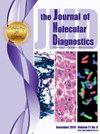用于检测常见甲状腺发育不良 I 型和 II 型突变的单一多重 PCR 和单核苷酸延伸测定。
IF 3.4
3区 医学
Q1 PATHOLOGY
引用次数: 0
摘要
突变分析可用于确认Thanatophoric dysplasia I型和II型(TDI和II)的临床和放射学诊断。我们开发了一种单复用 PCR 和单核苷酸延伸 (SNE) 检测方法,用于鉴定导致 99% 的 TD I 型和 TD II 型的 14 个常见突变,包括 FGFR3 基因第 18 号外显子终止密码子中具有挑战性的三个相邻突变。化验设计还提供了使用性能优化聚合物-7 (POP-7) 解决 SNE PCR 产物大小问题的解决方案。该检测方法使用 37 份先前鉴定过的、已去身份的患者样本进行了验证,这些样本代表了 9 种野生型和 10/14 种突变基因型。还合成了四种人工模板,以模拟现有患者样本中没有的四种 TD I 突变。用 GeneMarker v3.0 和 GeneMapper v6.0 软件对来自 10 个样本和 4 个人工模板的每个 SNE 产物的片段大小和荧光团通道进行定义,以便进行分析。等位基因的调用(面板内的分区位置)使用之前表征的其余 27 个样本进行了验证。这种 TD I 和 II PCR 及 SNE 检测法是一种强大的多重检测法,经过简化,可在一次反应中鉴定出 14 个突变。与传统的桑格测序或新一代测序相比,该检测性能和分析所需的周转时间更短。本文章由计算机程序翻译,如有差异,请以英文原文为准。
A Single Multiplex PCR and Single-Nucleotide Extension Assay for the Detection of Common Thanatophoric Dysplasia I and II Mutations
Mutation analysis provides confirmation of a clinical and radiological diagnosis of thanatophoric dysplasia types I and II (TD I and II). We developed a single multiplexed PCR and a single-nucleotide extension (SNE) assay to identify 14 common mutations causing 99% of TD I and TD II, including the challenging three adjacent mutations in the stop codon of exon 18 of the FGFR3 gene. The assay design also provides a solution for resolving SNE PCR product sizing using performance optimized polymer-7. The assay was validated using 37 previously characterized, de-identified patient samples representing the nine wild-types and 10 of 14 mutant genotypes. Four artificial templates were synthesized to mimic four TD I mutations not represented in the available patient samples. Fragment size and fluorophore channel for each SNE product from 10 samples and the four artificial templates were used to define bins and panels for analysis with GeneMarker version 3.0 and GeneMapper version 6.0 software. Allele calls (bin placement within the panels) were verified using the remaining 27 previously characterized samples. This TD I and II PCR and SNE assay is a robust multiplexed assay, streamlined, to identify 14 mutations in one single reaction. This assay has a shorter turnaround time in comparison to traditional Sanger or next-generation sequencing.
求助全文
通过发布文献求助,成功后即可免费获取论文全文。
去求助
来源期刊
CiteScore
8.10
自引率
2.40%
发文量
143
审稿时长
43 days
期刊介绍:
The Journal of Molecular Diagnostics, the official publication of the Association for Molecular Pathology (AMP), co-owned by the American Society for Investigative Pathology (ASIP), seeks to publish high quality original papers on scientific advances in the translation and validation of molecular discoveries in medicine into the clinical diagnostic setting, and the description and application of technological advances in the field of molecular diagnostic medicine. The editors welcome for review articles that contain: novel discoveries or clinicopathologic correlations including studies in oncology, infectious diseases, inherited diseases, predisposition to disease, clinical informatics, or the description of polymorphisms linked to disease states or normal variations; the application of diagnostic methodologies in clinical trials; or the development of new or improved molecular methods which may be applied to diagnosis or monitoring of disease or disease predisposition.

 求助内容:
求助内容: 应助结果提醒方式:
应助结果提醒方式:


